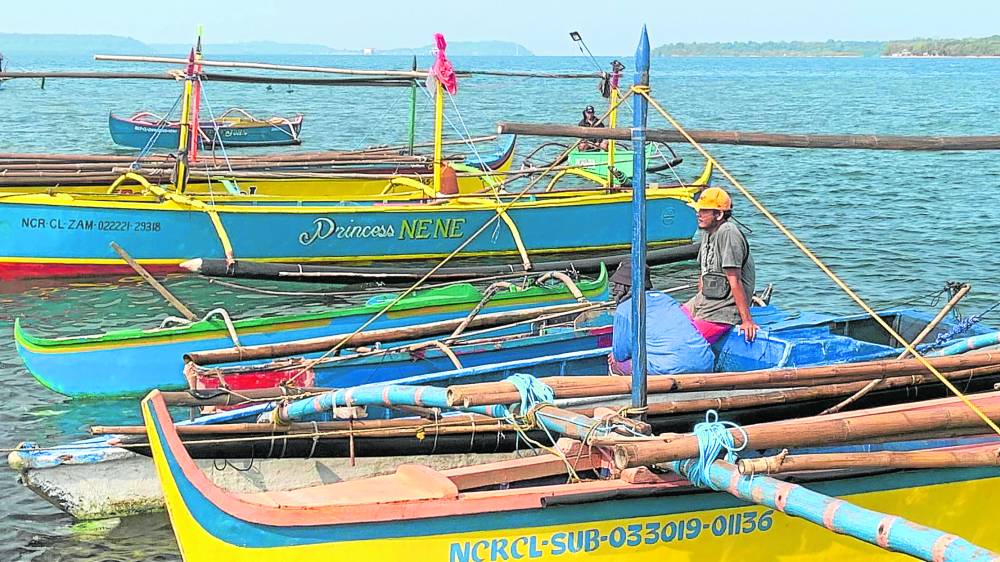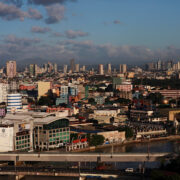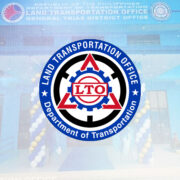Filipino fishermen caught in debt net in SCS row


DREADED ENCOUNTERS Fishermen in Masinloc town, Zambales, three of them in this photo taken on April 26, are nearly out of livelihood options as the menacing Chinese presence keeps them off their traditional fishing grounds. —JOANNA ROSE AGLIBOT
.
MASINLOC, Philippines—Ever since he was a teenager, Filipino fisherman Rony Drio has been sailing into the heart of the South China Sea (SCS) to fish at Panatag (Scarborough) Shoal, a large atoll rich in fish stocks that has become one of Asia’s most contested maritime features.But now, 56-year-old Drio said, it has become increasingly difficult and dangerous to fish at the atoll—some 200 kilometers (124 miles) off the Filipino coast—because of aggressive action by China, which claims the disputed shoal.Filipino fishermen in San Salvador Island in the Masinloc municipality told the Thomson Reuters Foundation that China was using speedboats and water cannon to block access to an area that is inside the Philippines exclusive economic zone (EEZ) but was seized by China in 2012.The skirmishes are taking place as the Philippines steps up its defense posture in the South China Sea, an area long seen as a potential flashpoint between the United States and China.The high seas drama has slashed the incomes of the fishermen of San Salvador Island. No longer able to fish freely at the atoll, and sometimes chased away before they have even caught anything, they are forced into the open sea.This costs more in fuel, leading many into a vicious cycle where each trip leaves them more indebted and thus forced to travel further next time to catch more fish.
The fishermen are also no longer able to shelter from storms in the turquoise lagoon of Panatag Shoal, making their trips more dangerous.
‘It’s a cycle’
“We were just trying to make a living but we were driven out. Many of us dread seeing China’s coast guards,” Drio said.“Everything we have now is debt. If you had a debt from a fishing trip, you need to sail again so you can pay for it and that incurs another debt … It’s a cycle,” he said.Jimmy Tabat, another fisherman from Masinloc, said three days on the shoal used to yield enough fish to feed fishermen’s families and leave them with some savings.
“Fishing trips inside the shoal consume less fuel and produce more fish than (in) the deeper open sea,” said the 45-year-old.The Scarborough Shoal is named after a British ship that was grounded here in 1748 but is known to Filipinos as Bajo de Masinloc or Panatag—a Tagalog word for “peaceful.”
An international tribunal invalidated China’s claim to 90 percent of the South China Sea in 2016 but Beijing does not recognize the ruling. Since it seized the shoal in 2012, it has maintained a constant deployment of coast guard and fishing trawlers.
The Chinese Embassy in Manila did not immediately reply to requests for comment on this story.There was some respite for Filipino fishermen after Rodrigo Duterte came to power in Manila in 2016 and relations with China improved. Fishermen were allowed back to the shoal but tensions have mounted since Ferdinand Marcos Jr., who has forged closer ties with Washington, became president last year.Drio said fishermen were suffering mentally as well as economically with some reporting anxiety attacks and trauma.
“I can only hope that we can fish freely again on the shoal with a peaceful mind,” he said as he sat near his fishing boat on the coast of San Salvador. “That area is ours.”
Fishing at a loss
Pamalakaya, a national alliance of fishermen, said fishermen in Zambales province have lost around 70 percent of their income because of restrictions on access to the shallow, bountiful waters of Panatag Shoal.Tabat said that before 2012, a fisherman could earn P8,000 to P10,000 ($145-$180) a week but that has plunged to around P2,000-P3,000, meaning it can take three weeks to catch enough fish to break even. “We were fishing at a loss. At times we could take nothing home,” Tabat said.
The Bureau of Fisheries and Aquatic Resources (BFAR) said the South China Sea is an important fishing ground for over 385,000 registered fishermen, contributing a total of 304,000 metric tons of fish from 2018 to 2022.
A study last year by the Peoples Development Institute (PDI), a nongovernment organization focusing on asset reform and rural development, found that fishing at Panatag Shoal before 2012 could yield up to three tons of various high-value species per fishing trip.
But it is now becoming “economically unfeasible” to fish in the area due to dwindling catches, destruction of coral reefs, harassment by Chinese vessels, and inclement weather, with fishermen unable to shelter in the shoal, the study said.
It also said China was destroying the coral reef at Panatag through giant clam digging operations, in which coral reefs are pulverized to gather the clams underneath.
Fight for rights
In September, the Philippine Coast Guard said there was “extensive damage in areas frequented by Chinese militia” in the West Philippine Sea, Manila’s term for waters in the South China Sea that fall within its 370-km EEZ.Aurea Miclat-Teves, executive director of the PDI, said her group would like to see the creation of a charter that would outline the Philippine government’s obligation to protect fishing rights in the area.The fishermen are also taking action. In 2020, more than 1,000 fishermen in Zambales and nearby provinces formed the Bigkis Fisherfolk Federation to defend their freedom to fish on the shoal.
“We formed a group because our pleas had fallen on deaf ears before. We were ignored,” said Henrelito Empoc, a Masinloc fisherman and the group’s spokesperson.Empoc said the group has urged the government to adopt a more assertive approach to reclaim and manage the country’s EEZ. They also want the government to permanently deploy Filipino coast guards on Panatag Shoal and create alternative livelihoods for struggling fishermen in Masinloc and elsewhere.
The BFAR says it has created an P80-million livelihood project for fishermen and also conducts resupply missions to fishing boats in the West Philippine Sea, providing engine oil, drinking water and snacks to those out on the water.For example, a resupply mission to the Spratly Islands, which are also disputed, will be carried out by civilians with the help of the coast guard on Dec. 10.
Drio is grateful for government support but says that help in the past has been poorly managed, with a proposed seaweed farming project unsuited to the area’s waters, while donated boats were no good for long fishing trips.“When the sea rumbles, a fisherman’s stomach will also rumble,” he said. “We want the government to help us so we can fish again for our families without worry.” —THOMSON Reuters foundation
















